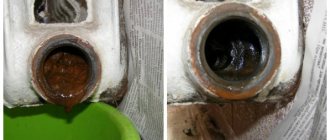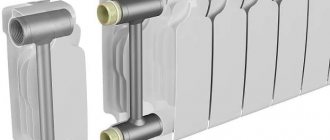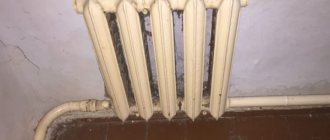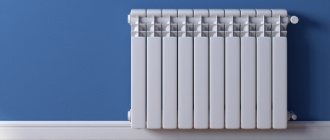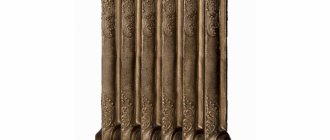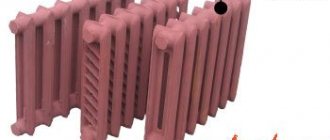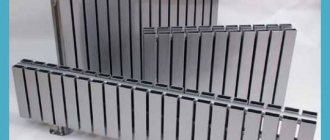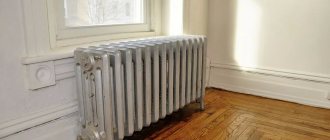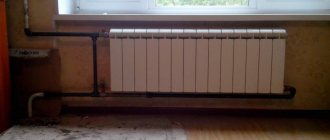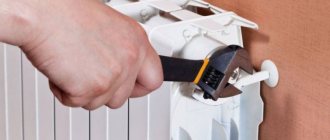Cast iron radiators in the interior are still in demand. They fit originally into almost any stylistic direction of room design, have a lot of advantages, and are sold in different variations. You will learn more about the use of this miracle element of Soviet heating in our article. Moreover, as part of the publication, we will consider the distinctive features of the appearance of durable batteries, which can easily be made the accent of a room for any purpose.
Cast iron radiator with a symmetrical silver pattern Source teplokom.ru
Cast iron retro heating radiators
Antique cast iron batteries can become a feature of the interior of a country house.
Such designer radiators are usually installed in houses that are not connected to the central gas supply system. It is believed that the thermal energy released by cast iron batteries is more useful than the heat generated by modern heating devices.
Cast iron appliances can be decorated with your own hands or purchased with an antique finish. Such heating radiators have original patterns of beautiful colors on their surface, the side sections stand on graceful legs. Radiators are made only from the highest quality metal.
Design styles for cast iron batteries
It is no longer possible to say that cast iron radiators look rude and ugly, since modern manufacturers offer consumers various aesthetic appearances of the declared designs and emphasize various interior styles. More about this.
All batteries made of cast iron are conventionally divided into simple (traditional) and decorative. The first options are more suitable for interiors with a focus on modernism, minimalism, loft and other industrial trends. Decorative styles include options that suit the interior of classic, Provence, rustic, pompous rococo or baroque. English and Empire interiors also involve the use of decorative radiators.
Low white cast iron radiator on graceful legs to match the classic interior style Source blog.postel-deluxe.ru
Characteristics of retro style batteries
The range of designer cast iron radiators is wide: you can choose a heating device to suit almost any interior. The radiator can be painted in any shade, have beautiful patterns or be plain, have a different number of sections and legs of different shapes.
The cast iron unit is completely protected from various harmful impurities in the water. You don’t have to fill the system with a special coolant, but use regular tap water.
With the help of such devices, you can effectively heat even the coldest rooms, because a cast iron radiator can operate uninterruptedly at a water temperature in the pipes of 110 degrees. The temperature is maintained for a very long time due to the distribution of energy output: a third is lost by convection, that is, by the release of heated air, and the rest by radiation.
Old heating devices are restored by covering the cast iron surface with a primer or epoxy resin, which allows the device to be repainted in any color.
The entire procedure can be done with your own hands. Negative sides:
Selection and average prices for cast iron radiators
Due to their large mass, such heating devices cannot be hung on the wall. Therefore, almost all available models have legs.
The main part of cast iron batteries is created in a style that revives Baroque, Rococo or Empire style. Not only the heat exchange device itself is made in a retro style, but also pipes, valves, and even the boiler can be made in an antique design. is also important, which can be monotonous or patterned.
The main manufacturers of cast iron heating appliances:
Why cast iron radiators have not gone out of fashion
Durable, thick-walled radiator batteries continue to be popular today. This is attributed precisely to the advantages that cannot be found in modern bimetallic or aluminum heating structures:
- durability. This equipment, if properly handled, can last up to 30 years; it can withstand pressure;
- basic service. Provides convenient cleaning, etching, rinsing, and water filling;
- increased wear resistance. The presence of a silicon layer on the surface of the radiator allows the structure to last longer and withstand all kinds of mechanical stress;
- no restrictions when choosing coloring compositions. You can use any means; they will not affect the structure of the cast iron material due to the thick walls. But it is better to paint on a cold surface;
- wide range of models. Cast iron batteries are very diverse. They differ in shape, number of sections, design (there are variations with a relief surface). They also differ in the method of connection to the heating system;
- high energy efficiency. The cast iron material is quite thick, so it takes a long time to heat up, and therefore retains heat many times longer. Due to the gradual release of heat, cast iron is able to evenly heat even the largest rooms.
Installation details
If you have to install cast iron batteries yourself, you need to take into account some important points. Antique items are not hung on the wall.
Depending on the type of existing system (one or two pipes), you need to select suitable additional elements: couplings, shut-off valves, etc. Balancing valves are difficult to install.
Before you start installing devices,
you need to learn the following requirements and strictly follow them: You can also make a retro heating radiator yourself . To do this you need a little imagination, temperature-resistant paints and the radiator itself. You can purchase such a radiator from some owners or even get it for free.
To give it an antique look and decorate it, you need to remove the old paint.
Any solvent will do for this. Next, the unit needs to be painted with powder paint, which will be resistant to high temperatures. Next, design ideas come into play - various beautiful patterns are applied to the surface of the device. The last step is to apply two layers of varnish, after which you can begin installation. Source
Finishing radiators, or how to decorate a cast iron radiator
Many houses still have cast iron heating radiators, and their owners are in no hurry to say goodbye to them. And this is not without reason! After all, they have a lot of advantages that can well satisfy the needs of a private owner in heating his premises. One of the disadvantages of such products is considered to be a low level of aesthetics, however, this is a fixable matter and what their creators did not provide to the radiators, you can always do it yourself. Finishing radiators - this is what will be discussed in this article.
Modern cast iron radiators
Now you will learn how you can turn simple and unsightly products into beautiful heating batteries with virtually no material costs.
Possible decoration options
If you ask a homeowner how he can quickly, effectively and most importantly inexpensively make beautiful heating radiators in his home, he will most likely have difficulty answering.
And the box just opened...
Decoupage of an old battery
In fact, there are a lot of options that will help transform your heating devices, giving them completeness and exclusivity. Let's list all the possible methods that can help create beauty and finally complement the interior design of a room:
Important! Decorating by painting radiators is a rather labor-intensive and painstaking process, so not every owner of a private home will want to use this method. In addition, advice immediately follows from this - use painting if your heating system is at the construction stage or you are going to repair radiators.
Important! When creating a screen, you need to select materials so that they do not create obstacles to the flow of warm air, otherwise the room will not warm up well enough.
And now the most interesting part - because next we will talk about how to finish heating radiators with your own hands. Let's take a closer look at the simplest, most economical type of decoration - decoupage, namely, where it is used and how it can be done at home.
Comparison with modern options
When faced with a choice between radiator options for a modern type of heating, attention is often paid to aluminum, steel or bimetallic structures. At the same time, they believe that cast iron battery models are old-fashioned and ugly.
In fact, they provide good competition to the listed analogues. For example, a cast iron radiator costs less (if it is not a retro model), but lasts much longer than those made of a thin metal alloy. The latter fail much faster: they soon begin to rust, and therefore often need major repairs or replacement. And this is additional waste.
Massive cast iron radiator in antique style for an elegant interior Source kermi-fko.ru
What is decoupage and how did it appear?
Today, photos of decoupage heating batteries can be found everywhere - both on the Internet and in the catalogs of designers who so kindly offer their services in such a simple matter at a high cost. Why pay more if you can do it yourself, although more on that a little later, but now let’s dive into history to see when decoupage appeared, and also what they were used for.
Art originated in China at the dawn of the 12th century, and subsequently smoothly migrated to Europe, where it was most widely used in France. The method is based on cutting out various shapes or patterns from fabric, leather or paper, and then gluing them onto some surface.
In those days, decoupage was performed on:
In general, as soon as China shared the art, Europeans immediately began to apply it wherever possible. Well, today this method has smoothly transferred to radiators, allowing owners of private houses to decoupage heating radiators with their own hands without the help of designers.
Decorating heating radiators using decoupage method
Preparing the battery for painting
Well, now let's look at how this decoration is done, what is called under a microscope. As mentioned earlier, this job is very simple to do, to convert the radiator you will not need many things, but you will need the following:
Now a few words about choosing a napkin for converting a radiator; they are chosen out of the need to emphasize the batteries or simply to disguise the product to match the design of the room. The same is with varnish - its choice is based on your preferences and goals that guide you. This is clear, so now you can start decorating:
Painting a cast iron battery
Tip : Before moving on to the stage of gluing your napkins, it would be advisable to place a towel or an old newspaper under the heating radiator. This will protect your flooring from getting glue on it. If the material drips onto the parquet, there is nothing wrong with that, but if it is a carpet or a carpet, then problems will arise.
Tip : It is better to remove the top layer before cutting the napkin into pieces - it will be much easier this way, and there is much less chance of damaging it.
Important! Be careful - the top layer absorbs the glue very quickly, which makes its structure very fragile, so glue it carefully and try to do everything the first time.
Important! The material has absorbed moisture from the glue, which means its structure is currently unstable - just remember this so that your movements are not rough - this will ruin the napkin.
At this point, do-it-yourself decoupage of heating batteries can be considered complete. Thanks to all of the above, you can easily and simply cope with such a simple job. Now, if you are interested in this method of decorating batteries, you are probably wondering where you can buy everything you need to decorate using this method?
Where can I buy everything I need for decoupage?
Decoupage tools
You shouldn’t have any questions about where you can get glue and brushes for painting, because you can buy them at any office supply store. The problem is that not everyone knows the places that offer a selection of interesting napkins with bright designs. To do this, just visit a large store specializing in household goods. As a rule, it contains a large selection of napkins - this is where you are guaranteed to select the appropriate material for decoupage.
It is best to buy paint and varnish materials in stores that sell products for artists. There on the shelves you can find a variety of options, with different effects - matte, glossy, etc. When choosing, be guided by the goals that decoupage should fulfill:
Remember! The varnish must be heat-resistant and can easily withstand temperatures of at least 150 degrees.
Well, for fine-grained sandpaper, it’s best to go to a hardware store, and then from the offered assortment choose the cheapest option for cleaning the surface of your cast-iron battery.
This concludes the question: how to create colored heating radiators in a private house - you can close it, because now you know such a unique method as decoupage.
Did you like the article? Subscribe to the channel to stay up to date with the most interesting materials
Source
Retro radiators: stylizing the heating system as antique
Essential attributes of modern life are high-tech gadgets, innovative materials, and creative ideas. But not everyone likes this dominance of progress. Many people prefer to surround themselves with things with history, vintage, retro, or even antiques, if they have the financial means for this. Classic conservative interior styles are always relevant; designers create them using real antique or antique-style furniture. But in a home furnished with elegant antique furniture, heating devices of the 21st century look like alien elements. Cast iron radiators made in retro style look much more organic.
Antique-style radiators, like their antique prototypes, are made of cast iron. It was also used to make the first batteries, which began to be produced in the second half of the 19th century. After the appearance of the first cast iron heating radiators, they were made exclusively from this metal for a long time. “Accordions” made of cast iron were widely used for arranging heating systems for various purposes: residential apartments, houses and cottages, commercial establishments, administrative buildings, etc. Due to their widespread use over a long period of time, even the twentieth century in terms of heating began to be called cast iron.
Advantages and disadvantages
Among the advantages of cast iron retro radiators, we note the following:
- Anti-corrosion resistance. Thanks to this feature, cast iron radiators can last 100 years.
- Resistance to various impurities contained in water.
- Durability.
- Slow cooling. Even if the heating is turned off, the batteries will give off heat for a long time.
- Cast iron radiators can operate at temperatures of 110°C.
- The surface of the retro-style battery models is covered with polyester enamel. This means that, if desired, the device can be repainted in any other color.
- Beautiful design.
The characteristics of cast iron radiators can be found here.
But there are also disadvantages:
- heavy weight, which may cause difficulties during installation and movement;
- It is difficult to remove dust between sections;
- high cost, products made in retro style are more expensive than radiators made of aluminum or steel.
The efficiency of batteries is influenced not only by the parameters, but also by the correct calculation and installation of the entire heating system.
Reliability and durability
Heating batteries can be steel, copper-aluminum or simply aluminum, bimetallic and cast iron, but only the latter have passed the test of time and proven high reliability. For example, today the oldest, but properly functioning cast iron radiator in the heating system, which was produced and installed 108 years ago, is officially registered. Today, manufacturers of retro radiators use modern technologies for melting cast iron and casting batteries of various shapes with spectacular relief patterns. Heating devices are subjected to special kiln firing, priming and drying in special chambers.
Specifications
We have already named one of the reasons why Soviet cast-iron heating radiators lost their popularity - a monotonous, dull design. But besides this, “accordions”, as they were aptly dubbed by the people because of their characteristic shape, had much weaker heat transfer than the aluminum analogues that appeared, and then bimetallic devices. Advanced cast iron technology made it possible to correct design flaws.
The technical characteristics have also changed significantly. For radiators of the MS-140 type, produced in Soviet times, the maximum operating pressure was only 6 bar; for current “antique” batteries, this figure is much higher. For example, retro radiators of the domestic brand EXEMET and the Czech brand VIADRUS operate normally at a pressure of 10 bar, and are tested at 15. Turkish devices of the Demir Dokum brand operate at a slightly lower pressure of 9 bar, but are tested the same fifteen.
A number of European manufacturers of antique-style batteries, for example, the German GURATEC, produce devices with an operating pressure of only 6 bar. Their products are aimed at consumers from European countries and are not intended for use in Russian realities.
But if there are no problems with the working pressure of cast iron radiators, then nothing has changed with heat transfer. Even in modern cast iron batteries produced using new technologies, it is weak. Nothing can be done about this, because heat transfer directly depends on the thermal conductivity of the material - in this case, gray cast iron. Let's give an example: if we take one section of a retro battery of the Demir Dokum brand, the mounting height of which is 500 mm, then the power of its heat flow will be equal to 160 W. For a bimetallic section with similar parameters, this figure will be at least 190 W. The heat transfer of the bimetallic section is much higher. The thickness of the battery walls plays an important role in this. In order for brittle cast iron to withstand the required coolant pressure, its layer must be thicker than the layer of steel or silumin.
As for the dimensions of antique batteries, the center distance and height vary slightly among all manufacturers. Average center distances can be 350, 500, 600, 750, 800 and 950 mm. But in terms of width, even within the line of one manufacturer, the values can differ significantly, since the shapes and designs of retro batteries are extremely diverse.
Types of radiators in retro style
An important feature by which retro batteries can be classified is the way they are fixed. Depending on it, “antique” radiators are:
Hanging - this type of battery allows designers to smoothly introduce stylized heating devices into the interior. With suspended models it is easier to make a hidden connection. They are usually mounted on mounting hooks pre-installed into the wall. Hanging radiators in retro style look impressive, neat and aesthetically pleasing.
On legs - such batteries are universal in installation, they do not put a load on the walls, so they are suitable for installation even near a plasterboard partition. Equipping heavy cast iron radiators with beautiful shaped legs is the optimal solution, especially if the room has a reliable floor and the walls are not permanent. Batteries on legs are installed quickly and easily, but the floor must be durable and not sloped.
By design, antique radiators are divided into:
Sectional - allow you to increase the battery to the required size before or during operation by attaching additional segments of identical parameters and configuration. Sectional retro radiators are in active demand due to this possibility of adjusting their heating power.
Monolithic - they can not be found as often as sectional ones; they are made mainly to order, for a specific project. In practice, monolithic radiators have proven to be more reliable than sectional ones. They are made of one-piece casting and do not have connecting seams, which minimizes the risk of leaks.
Features of modern retro radiators
There are quite a large number of cast iron radiators on the modern market, differing in shape, color palette and features of technological implementation.
Two main types of products:
- Sectional type devices. They have a convenient mechanism for adding or removing sections, which allows you to more accurately select a radiator based on the square footage of the room and potential heat losses.
- Solid type devices. They do not have seams or jumpers, which significantly increases the protection of batteries from leaks and breakdowns.
The appearance is determined by the buyer
Cast iron retro radiators are often supplied to the market in factory primer, without a final paint coating. This is done specifically so that the buyer has the opportunity to independently choose the finishing option for the purchased batteries. Sellers can offer the following design options for heating devices:
matte monochrome painting with a choice of colors according to the RAL scale;
two-color painting with highlighting of the ornament;
painting with polishing varnish;
patination of bronze, copper, silver.
Why we choose cast iron retro
The main argument in favor of this choice is the magnificent design of radiators, stylized in antique style, with exquisite patterns, spectacular decor, a variety of shapes and colors. But there are other advantages to this type of battery. These include:
Long service life - cast iron is not afraid of corrosion, and it is also not afraid of prolonged contact with coolants with aggressive chemical properties. Thanks to this, retro-styled batteries last for a very long time; only manufacturers provide a guarantee for several decades, so a cast-iron device can easily be used for half a century.
Versatility of application - cast iron retro radiators made using new technologies are able to withstand high coolant pressure, so they can be installed at facilities for any purpose, with the exception of multi-apartment high-rise buildings.
Inertness - thick-walled cast iron radiators heat up slowly, but these heating devices cool down longer than any other.
Let's talk about the cons
The main disadvantage of retro radiators is their high cost. Their price can be double, triple, or even more than the cost of aluminum analogues. Another important disadvantage that makes it difficult to transport and install stylized cast iron batteries is the heavy weight of the devices. In addition, radiators of this type contain a large volume of coolant, which increases their inertia and prevents the use of thermostatic valves. Well, we have already mentioned weak heat transfer. That is, to heat a room with a cast iron radiator, you need to use a larger number of sections than is required for, for example, a bimetallic radiator. The increased number of sections in the battery automatically increases the cost of the retro heating device.
Advantages and disadvantages
Obvious advantages of cast iron retro radiators:
- Corrosion resistance and immunity to harmful abrasive water impurities. These properties are due to the characteristics of the material itself.
- Durability. Products made of cast iron, subject to operating conditions, last up to one hundred years.
- High temperature threshold for normal operation. The devices remain functional at coolant temperatures up to 110 degrees Celsius.
- Slow cooling. When the coolant supply is turned off, cast iron radiators retain heat for a long period of time.
- Possibility of changing shade. Most modern models of cast iron retro batteries are coated with polyester enamel, which makes them easy to repaint if necessary.
- Original design. Vintage and classics provide great scope for any design solution.
The main disadvantages of cast iron structures for heating systems:
- Considerable mass. Creates certain inconveniences during transportation and installation of radiators.
- High price. The price of retro-style cast iron radiators is higher than their steel or aluminum counterparts.
- Inconvenience during external cleaning. Mostly associated with poor accessibility to the intersection space as part of the dust removal procedure.
The efficiency of cast iron radiators depends not only on the selected product model, but also on the correct calculation of the heating system layout and the quality of the installation.
The nuances of installing retro batteries
If you bought antique-style radiators without a finishing coating, we recommend painting them or applying another finish before installing the batteries in the system and connecting them. This way, the wall on which they are mounted will not interfere with you, and the high temperature of the device connected to the heating system will not become a problem. Take care of the base for mounting the radiator: you need a solid floor for floor-mounted installation of the radiator or a solid wall into which brackets for hanging wall-mounted models are mounted.
It is advisable to lay the coolant lines for connecting the radiator to the system secretly, in the wall or under the floor, after installing the device in a permanent place. This is due to the fact that often the interval between the axes of retro batteries has significant errors; pre-installed pipes may not align with the nozzles.
When choosing elements of shut-off valves for a system made in retro style, you need to maintain stylistic unity. Modern taps and plugs will look simply ridiculous on “vintage” radiators. To prevent such obvious dissonance, it is necessary to purchase and install retro-style faucets, modern, but outwardly imitating ancient ones.
Retro radiators - cast iron heating radiators (batteries)
Cast iron retro radiators are popular cast iron heating radiators in Retro style. They are represented by a wide range of heating devices of different brands - Guratec (Germany), Viadrus (Czech Republic), Exemet (Russia), RetroStyle (Russia), Demir Dokum (Turkey), Fakora (Poland).
Radiators in retro style differ not only in design, shape, style of patterned ornaments, color, but also in their technical characteristics - height, depth, width, thermal power.
Cast iron retro batteries can have a final finishing color made in production or supplied primed. Radiators in the ground make it possible to paint them in any color you choose with special heat-resistant paints or decorate them using various techniques.
Retro radiators are an ideal solution for heating rooms made in the style of Italian Baroque, French Rococo, imperial style of the era of Napoleon I - Empire, as well as in modern styles - Loft, Industrial, High-tech.
Among the variety of antique radiators, you can always buy models that will harmoniously match other stylistic solutions of the interior, such as Classicism, Renaissance and even Gothic.
Retro radiators up to 500 mm high
| Hellas (410 mm) | Apollo (466 mm) | Tower (480 mm) | Rococo (490 mm) |
Retro radiators 500-700 mm high
| Merkur (506 mm) | Artdeco (506 mm) | Historic (510 mm) | Diana (600 mm) |
| Hellas (610 mm) | Bohemia (640 mm) | Bohemia R (640 mm) | Tower 4066 (660 mm) |
| Retro (661 mm) | Historic (661 mm) | Gothica (663 mm) | Versailles (675 mm) |
Retro radiators 700-900 mm high
| Dragon (735 mm) | Apollo (750 mm) | Jupiter (752 mm) | Artdeco (760 mm) |
| Merkur (760 mm) | Retro (760 mm) | Historic (760 mm) | Rococo (790 mm) |
| Leicester (790 mm) | Fortuna (800 mm) | Radiator |
Retro radiators over 900 mm high
| Apollo (950 mm) | Historic (955 mm) | Retro (954 mm) | Rococo (960 mm) |
| Mangus (980 mm) | Oxford (985 mm) | Bohemia (990 mm) |
Valves for connecting retro radiators to the heating system
| Carlo Poletti valves | SRRubinetterie valves | Classic Comfort valves |
To connect cast-iron retro radiators to the pipes of the heating system, designer valves and taps from the Italian companies Carlo Poletti and SR Rubinetterie are used. They blend very organically with these radiators.
Retro radiators are heating devices, sections of which are made using artistic cast iron. The relief ornaments and patterns on the side surfaces of the sections are based on ancient models of European and North American cast iron radiators of the late 19th and early 20th centuries.
Cast iron radiators in retro style, installed on the floor (on legs), are not only a source of heat, but also represent solid and high-quality interior items.
In recent decades, due to the massive advance of heating radiators made from other, cheaper and easier to produce metals and alloys, there has been a tendency to reduce factories producing cast iron radiators. And perhaps the time will come when a beautiful patterned cast iron radiator will become a real family heirloom or even an antique in your home.
Brief overview of popular manufacturers
Retro radiators of both domestic and foreign production are represented on the Russian market of heating devices. Among Russian batteries, the most popular are Radimax and Exemet. Their products are spectacular sectionals, patterned and smooth. Such radiators have gained recognition not only in Russia, but also among domestic consumers. Products are successfully exported to a number of foreign countries. The collections of these companies are represented by a wide model line. Spectacular batteries are also distinguished by a variety of finishes.
Popular foreign brands are represented by the trademarks Viadrus, Demir dokum and GuRaTec. Viadrus is a well-known Czech brand that has been producing retro wall and floor radiators equipped with legs for many years. The company has established itself as a manufacturer of consistently high quality products. Cast iron retro batteries with good heat dissipation are supplied under the Turkish brand Demir dokum; the collection consists mainly of floor-standing models. GuRaTec brand batteries are traditional German quality, a classic range of discreet shapes and a moderate color palette.
Selection rules
In addition to the appearance of retro-style cast iron batteries and the price of the products, you should definitely consider:
- Power. The average value for residential apartments/houses is 120 W per 1 square meter of space.
- Operating pressure. Foreign-made products usually have a lower value of this parameter compared to domestic analogues. Choose a radiator with a pressure reserve of 20-25 percent.
- Guarantee. For quality products, 25 years or more is optimal.
The main brands represented on the modern domestic market.
- Russian Radion, Retro Style;
- German Garatec;
- Turkish Demir Dokum.
Retro radiators - the choice of connoisseurs of beauty and tradition
Heating devices whose design is inspired by radiators that warmed people a century and a half ago. The beautiful shapes of the sections and legs, the exquisite relief patterns evoke admiration. But not everyone can afford to purchase and install retro batteries. If you are used to surrounding yourself with truly beautiful things and objects, the stylish design of which never gets boring, and you have the financial means for this, decorate your home with retro radiators, and its interiors will sparkle with new colors.
Features of retro radiators
On the heating equipment market you can find retro radiators made in various shapes and models. The color palette of such heaters is also large. According to production technology, batteries can be solid or sectional.
Sectional radiators are very popular because... the ability to select the number of sections allows you to purchase a device based on the heat loss of the room. In addition, at any time you can add a section or, on the contrary, remove it.
Solid-piece batteries are much less common, even though they are more reliable. Radiators are made without seams, so the risk that the device may leak is minimal.
